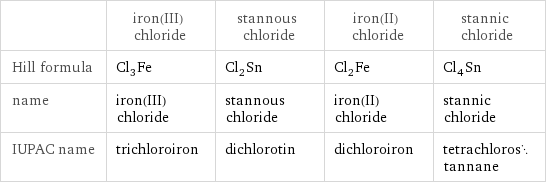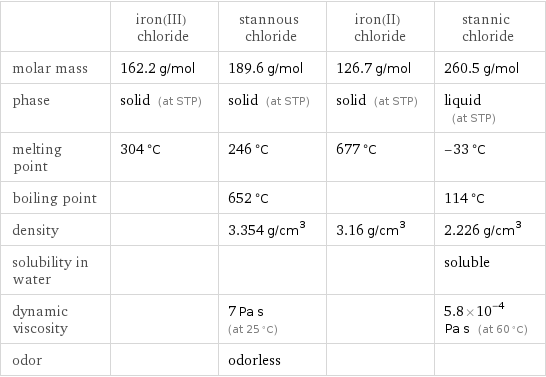Input interpretation

iron(III) chloride + stannous chloride ⟶ iron(II) chloride + stannic chloride
Balanced equation

Balance the chemical equation algebraically: + ⟶ + Add stoichiometric coefficients, c_i, to the reactants and products: c_1 + c_2 ⟶ c_3 + c_4 Set the number of atoms in the reactants equal to the number of atoms in the products for Cl, Fe and Sn: Cl: | 3 c_1 + 2 c_2 = 2 c_3 + 4 c_4 Fe: | c_1 = c_3 Sn: | c_2 = c_4 Since the coefficients are relative quantities and underdetermined, choose a coefficient to set arbitrarily. To keep the coefficients small, the arbitrary value is ordinarily one. For instance, set c_2 = 1 and solve the system of equations for the remaining coefficients: c_1 = 2 c_2 = 1 c_3 = 2 c_4 = 1 Substitute the coefficients into the chemical reaction to obtain the balanced equation: Answer: | | 2 + ⟶ 2 +
Structures

+ ⟶ +
Names

iron(III) chloride + stannous chloride ⟶ iron(II) chloride + stannic chloride
Chemical names and formulas

| iron(III) chloride | stannous chloride | iron(II) chloride | stannic chloride Hill formula | Cl_3Fe | Cl_2Sn | Cl_2Fe | Cl_4Sn name | iron(III) chloride | stannous chloride | iron(II) chloride | stannic chloride IUPAC name | trichloroiron | dichlorotin | dichloroiron | tetrachlorostannane
Substance properties

| iron(III) chloride | stannous chloride | iron(II) chloride | stannic chloride molar mass | 162.2 g/mol | 189.6 g/mol | 126.7 g/mol | 260.5 g/mol phase | solid (at STP) | solid (at STP) | solid (at STP) | liquid (at STP) melting point | 304 °C | 246 °C | 677 °C | -33 °C boiling point | | 652 °C | | 114 °C density | | 3.354 g/cm^3 | 3.16 g/cm^3 | 2.226 g/cm^3 solubility in water | | | | soluble dynamic viscosity | | 7 Pa s (at 25 °C) | | 5.8×10^-4 Pa s (at 60 °C) odor | | odorless | |
Units
